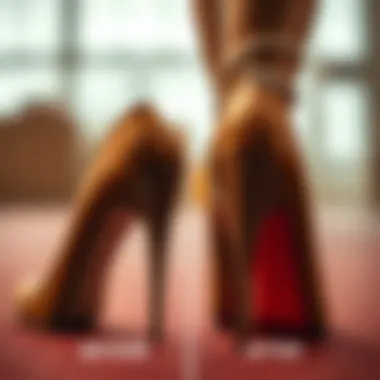Heel Fillers: A Guide to Footwear Enhancement


Intro
Understanding heel fillers extends beyond mere aesthetics; it's also about comfort and functionality. The modern landscape of footwear has been profoundly shaped by these often-overlooked details. Heel fillers can subtly elevate the look of shoes while improving wearability, drawing attention to the craftsmanship of the footwear while keeping comfort in check.
The journey of heel fillers is one that intersects fashion dynamics, influenced by seasonal trends and iconic figures within the industry. This guide aims to untangle the multifaceted nature of heel fillers, dissecting their materials, application techniques, and both the advantages and potential drawbacks of integrating them into footwear.
As we delve into this exploration, readers will gain insights applicable to fashion design, styling, and retail, enabling them to navigate the realm of heel fillers with confidence and informed purpose. From examining the latest trends to offering practical tips, this guide seeks to enrich your understanding and application of heel fillers in footwear.
Let's begin this journey through the evolving world of heel fillers.
Understanding Heel Fillers
In the realm of footwear, aesthetics and comfort often go hand in hand, and heel fillers are at the crossroads of these two essential elements. Understanding heel fillers is fundamental for anyone dabbling in footwear design, retail, or even for enthusiasts keen on enhancing their shoe collections. These fillers serve a specific purpose: they elevate the visual appeal of a shoe while also providing that much-needed comfort, especially in high-heeled designs. The role of heel fillers transcends mere aesthetics; they can redefine a shoe's performance and extend its lifespan.
Definition and Purpose
Heel fillers are specialized materials inserted into the heel section of shoes. They're designed to create a more pleasing silhouette while also cushioning the heel for better support. Imagine strutting around town in a stunning pair of stiletto heels, only to realize halfway through your day that your feet feel like they've just run a marathon. Heel fillers alleviate such discomfort, making the experience of wearing high-fashion footwear far more enjoyable.
Their primary purposes include:
- Aesthetic Enhancement: By providing a fuller shape to the heel, they contribute to the overall look of the shoe, making it appear more luxurious or trendy.
- Comfort Support: They cushion the heel, absorbing impact and reducing pressure, which is particularly beneficial for those who are on their feet for extended periods.
- Footwear Longevity: Properly used fillers can prevent structural damage, which can lead to cracking or misalignment in the heel over time.
Historical Context
The evolution of heel fillers reflects broader trends in fashion, technology, and consumer comfort. Historically, footwear was simply designed for utility, but as fashion advanced, the need for greater aesthetic appeal introduced various innovations in shoe design. Heel fillers emerged as a response to the increasing desire for both style and comfort, especially during the mid-20th century when women’s fashion took a leap into more daring, high-heeled designs.
In the 1960s, with the rise of mod fashion, heels soared in popularity, urging designers to find ways to enhance comfort without sacrificing style. Early implementations of heel fillers were rudimentary, focusing primarily on padding. Over the decades, innovations in materials spurred a dramatic shift in how heels were constructed. Today, we see a variety of materials—from gel to silicone—designed specifically for different types of footwear, highlighting the intricate balance between comfort and style.
This history not only contextualizes the importance of heel fillers but also illustrates how they have become a staple in a world where both fashion and functionality are non-negotiable elements of personal expression.
Types of Heel Fillers
When it comes to elevating footwear aesthetics, heel fillers play a pivotal role. Different types of heel fillers cater to various needs, preferences, and styles. Understanding the characteristics and benefits of each type provides insights that help fashion designers, stylists, and consumers make informed decisions about their footwear.
Silicone Fillers
Silicone fillers are widely embraced in the footwear industry for their flexibility and durability. These fillers offer a unique blend of comfort and shape retention, making them ideal for both fashion and functionality.
- Comfort: Silicone conforms to the contours of the foot, allowing for a snug fit without feeling too tight. This feature is especially beneficial in preventing blisters and irritation during wear.
- Durability: Known for their resilience, silicone fillers withstand the wear and tear of daily use, ensuring that shoes maintain their aesthetic appeal over time. They resist degradation from moisture and heat, thus preserving the pristine look of the footwear.
"Silicone's adaptability makes it a front-runner in the race for innovative footwear solutions."
- Easy Maintenance: Cleaning silicone fillers is a breeze; they can be wiped down with a damp cloth, making them a low-maintenance option for busy individuals.
Gel Fillers
Gel fillers have surged in popularity among those who prioritize comfort without sacrificing style. Gel is particularly celebrated for its cushioning ability; it absorbs shock effectively.
- Shock Absorption: This is especially important in high-heeled shoes where the impact on the heel can be significant. Gel fillers help in reducing the pressure on the foot, leading to prolonged comfort even during extended wear.
- Breathability: Some gel fillers incorporate breathable designs that help in moisture management. This feature is great for warmer climates, ensuring that the feet stay cooler and more comfortable throughout the day.
- Customization Options: Gel fillers can come in various thicknesses and shapes, allowing consumers to tailor their use based on personal preferences and specific footwear styles.
Foam Fillers
Foam fillers are another popular choice, often offering an affordable and effective solution for enhancing footwear. They are lightweight and can be a game-changer for gaining extra comfort and support.
- Weight Distribution: Foam fillers evenly distribute weight across the foot, decreasing pressure on sensitive areas such as the ball and heel. This characteristic is significant for people who spend long hours on their feet.
- Versatility: These fillers can be found in various forms, including memory foam, which contours to the foot upon wearing, providing an almost custom experience for the wearer.
- Budget-Friendly: Compared to silicone and gel, foam fillers often come at a lower price point, making them accessible for a broader audience.


Benefits of Using Heel Fillers
Heel fillers have come a long way in the fashion industry, not just acting as mere accessories, but as pivotal elements that enhance both the aesthetics and functionality of footwear. With the growing popularity of customized footwear, understanding the benefits that heel fillers provide is indispensable for fashion designers, retailers, and even everyday shoppers who wish to elevate their shoe game.
Aesthetic Enhancement
When it comes to the visual appeal of shoes, heel fillers play a crucial role. These fillers can modify the heel’s silhouette, adding volume or reshaping its contours. For instance, a pair of sleek heels can be adorned with silicone fillers to create a fuller, more striking appearance. This not only amplifies the shoes' elegance but can also play with proportions, bringing balance to the overall look.
Moreover, heel fillers come in various colors and finishes, allowing for customized options that can complement or even contrast with the main shoe design. This flexibility supports a myriad of styles, from classic to avant-garde, helping designers meet the diverse tastes of consumers.
"In the world of fashion, how a shoe looks can make or break an outfit. Heel fillers are not just functional but an artistic way to add flair to one's ensemble."
Improved Comfort
Footwear comfort is, arguably, one of the most crucial aspects for anyone who spends considerable time on their feet. Heel fillers enhance comfort by providing an additional layer of cushioning, which absorbs shock and reduces pressure on the foot. For individuals who frequently wear high-heeled shoes, this comfort factor can be the difference between a graceful walk and a painful experience.
It’s important to note that different materials serve different purposes; for instance, gel fillers tend to distribute weight evenly, alleviating discomfort. This feature is especially beneficial for those with foot conditions such as plantar fasciitis, providing essential support and reducing fatigue during long hours of wear.
Longevity of Footwear
Investing in quality footwear represents not only a financial commitment but also an emotional one. As such, ensuring these investments stand the test of time is vital. Heel fillers can extend the lifespan of shoes significantly. By reinforcing the heel structure and safeguarding against wear and tear, they prevent the breakdown of shoe materials, keeping them looking fresh and intact.
In terms of maintenance, heel fillers can often be replaced or repaired without having to discard the entire shoe, thus offering an eco-friendlier option. With the right care and attention, a well-maintained pair of shoes with heel fillers can serve as a staple in any wardrobe for years, marrying quality with style effectively.
Application Process for Heel Fillers
The application process for heel fillers is not just a technical step; it’s a crucial component that can elevate the aesthetics and functionality of footwear. Properly applying fillers ensures they perform as intended, providing both comfort and visual appeal. A smooth application can lead to a seamless finish, while sloppy work can result in an unsightly look, defeating the purpose in the first place. Attention to detail during this phase is what separates the amateurs from the pros in footwear modification.
Preparation of Footwear
Before any cosmetic work commences, preparation is key. This isn’t simply about gathering your tools and fillers, it involves ensuring the footwear is clean and suited for modification. Here’s how to effectively prepare your shoes for heel fillers:
- Cleaning: Remove any dirt or additional residue. Use a damp cloth followed by a dry one to avoid disrupting the adhesive that may be used in the process.
- Assessment: Look closely at the heel and surrounding areas. Check for damage that might need repair before applying fillers.
- Choosing the Right Filler: Depending on the shoe material and the aesthetic desired, decide whether you’ll be going with silicone, gel, or foam. Each has distinct qualities and benefits that can enhance your footwear.
- Gather Materials: Have everything ready, including the fillers, adhesive (if necessary), a sharp knife, and a flat surface for placing your shoes.
This preparation phase is not to be rushed; giving it the care it deserves will set the stage for a successful application.
Step-by-Step Application
Once the footwear is prepped, it’s time to get down to business. Here’s a concise step-by-step guide to applying heel fillers:
- Measure the Filler: Using a measuring device, find the exact amount of filler needed for the heel. Too little can lead to receding aesthetics, while too much results in an awkward bulky appearance.
- Mold the Filler: For silicone and gel fillers, shape them to fit snugly into the heel. This ensures a smooth transition from the footbed to the heel area.
- Adhere the Filler: If you are using an adhesive, apply a thin layer on the shoe’s heel base before placing the filler. Press down gently to secure it firmly without causing distortion.
- Let it Set: Depending on the material and adhesive, allow sufficient time for everything to cure. This is a critical waiting game; avoid using the footwear until it’s fully set.
Following these steps with precision alleviates issues in the long run and enhances footwear lifespan and comfort.
Finishing Touches
The job doesn’t end once the filler is applied. The final touches can make all the difference in achieving a polished look.
- Smoothing Out: Once the filler has cured, you may want to use sandpaper (fine grain) or a smoothing tool for the initial finish. This helps blend the new filler with the existing heel.
- Painting or Dying: If the color mismatch exists, it’s perfectly acceptable to dye or paint the area for uniformity. Make sure the dye or paint does not interact adversely with the filler material.
- Final Inspection: Take a good look at the heels. Anything that doesn’t look right needs rectifying before the shoes go back to regular use.
Remember, first impressions count. How you finish the project speaks volumes about your attention to detail.
By following these processes carefully, you’re not only enhancing the aesthetics of your footwear but also ensuring they remain comfortable and durable in the long run.
Safety Considerations
When it comes to heel fillers, safety is an unsung hero that too often gets overlooked. The potential risks associated with their use can carry a hefty weight if not navigated properly. Understanding the safety considerations behind heel fillers is paramount, particularly for fashion designers, stylists, and retailers, as it ensures both the attractiveness of the footwear and the well-being of the wearer.


Material Safety
Choosing the right materials for heel fillers does not just help in achieving that chic look; it plays a critical role in user safety. Several materials, like silicones or gels, are engineered to meet safety standards, but not all fillers are created equal. Testing for toxicity and reactions, especially with products that come into direct contact with skin, is essential. Ideally, manufacturers should provide certificates or documentation that prove their materials meet safety regulations.
- Look for ratings: Materials that have been rigorously tested for safety often bear certification marks that that assure customers of their credibility.
- Consult databases: Checking reputable sources like PubChem or Material Safety Data Sheets can clarify material properties and any associated hazards.
Potential Allergies
The risks of allergic reactions can be another dark horse in the realm of heel fillers. It might come as a surprise, but many fillers use synthetic substances that could provoke allergies in susceptible individuals. Common culprits for contact dermatitis or other skin reactions include certain types of silicone and some adhesives.
- Patch Test: Consider recommending customers perform a patch test before long-term usage. A small application on the skin can reveal reactions without the distress of a full commitment.
- Ingredients List: Encourage artisans and manufacturers to keep transparently clear ingredient lists. Simpler compositions generally carry less risk for allergies, allowing consumers to make informed choices.
"Being cautious is part of being truly stylish."
Proper Storage
All the safety measures in the world won't mean much if heel fillers are not stored correctly. Proper storage extends their lifespan and ensures they maintain their optimal properties. Ideally, they should be kept in a cool, dry place, away from direct sunlight, as UV rays can degrade materials over time.
- Avoiding extremes: Baselining the conditions under which fillers are kept can mitigate the potential for harmful breakdown products to form.
- Packaging matters: Sealing fillers in airtight containers can protect their integrity, keeping out moisture or contaminating agents that can lead to degradation.
With safety considerations firmly in mind, both consumers and providers can cultivate a more responsible approach towards heel fillers, ultimately enriching the footwear experience.
Ethical Implications in Footwear Modifications
In recent years, the discourse surrounding footwear modifications, such as heel fillers, has evolved beyond mere aesthetic preferences. As consumers become more aware of the environmental impact of their purchases, the ethical implications of using these products come into sharper focus. This section delves deep into the responsibility of both consumers and manufacturers when it comes to making informed choices and adopting sustainable practices in the realm of footwear.
Sustainable Material Choices
When selecting heel fillers, the materials used can significantly influence the overall environmental footprint of the product. Many traditional heel fillers are crafted from synthetic materials, which can be detrimental to the environment due to their non-biodegradability. This raises a critical question for designers and consumers alike: how can we make better choices?
Opting for sustainable options is increasingly viable. Some manufacturers are now offering eco-friendly alternatives made from recycled plastics or organic materials. These sustainable materials serve the dual purpose of minimizing environmental impact while still enhancing the aesthetic appeal and comfort of footwear. For instance, plant-based polyurethane is emerging as a popular choice. It combines flexibility and durability, allowing for a comfortable fit while reducing reliance on fossil fuels.
Furthermore, choosing local suppliers for materials can also reduce the carbon footprint associated with transportation. It's an approach that not only supports local economies but also fosters transparency in the sourcing process. By making conscious decisions about the materials used in heel fillers, both designers and consumers can play an integral role in promoting sustainability in the fashion industry.
Consumer Responsibility
As the conversation around ethical implications gains momentum, consumer responsibility cannot be understated. The decisions made by individuals hold substantial power, and the footwear industry is no exception. Choosing to purchase heel fillers that incorporate sustainable materials signifies not just a personal fashion statement, but also a commitment to environmental stewardship.
"An informed consumer is an empowered consumer."
This saying rings especially true in this context. By researching brands and their material sourcing practices, consumers can align their purchases with values that prioritize sustainability. Many brands now offer transparency reports detailing their manufacturing processes and environmental initiatives. This level of transparency allows consumers to feel confident about their choices, knowing they are supporting companies that align with their principles.
Moreover, engaging in dialogue about ethical footwear modifications is equally critical. Consumers can influence industry trends by voicing their preferences for sustainable options. This potential shift in demand can push brands to adapt, adopting greener practices.
In summation, the ethical implications of footwear modifications, particularly heel fillers, underscore the importance of choice and responsibility. By prioritizing sustainable material choices and embracing consumer responsibility, stakeholders—from designers to end-users—can foster a positive evolution in the fashion landscape that supports both ethical values and aesthetic enhancement.
Caring for Heel Fillers
Caring for heel fillers is an important aspect that often gets overlooked in the broader discourse surrounding footwear modification. These components, although small, can make a significant difference not only in the aesthetics of the shoes but also in their comfort and durability. Understanding how to properly maintain heel fillers ensures that your footwear remains stylish and functional over time.
When it comes to maintaining your heel fillers, there are a couple of key elements to keep in mind: cleaning techniques and repairing minor damages. Both considerations contribute to the longevity and appearance of your footwear.
Cleaning Techniques
Cleaning heel fillers is crucial because dust and grime can accumulate over time, affecting both the look and function. Typically, the material of the fillers determines the best cleaning method. Here are some common practices for different types of fillers:


- Silicone Fillers: A damp cloth with mild soap often does wonders. Gently wipe the surface, and avoid harsh chemicals that can break down the material.
- Gel Fillers: These require a bit more care. Use a soft cloth or sponge to clean them with lukewarm water. If the gel starts to lose its elasticity, it might be time to think about replacements.
- Foam Fillers: Vacuum these softly to remove debris. If stains persist, consider using a fabric-safe cleaner.
It’s best to clean your heel fillers regularly, perhaps every few weeks, to keep them looking fresh and to prevent any unpleasant odors from developing.
"A little maintenance goes a long way in keeping your footwear looking sharp."
Repairing Minor Damages
Sometimes, despite your best efforts, heel fillers can get damaged. Understanding how to repair these minor issues can save you money and keep your shoes in prime condition. Here are a few straightforward tips:
- For Tears or Cracks: Use a strong adhesive designed for shoe repair. Apply a small amount in the damaged area and allow it to set according to the manufacturer’s instructions.
- If the Shape is Compromised: For foam fillers that have lost their original form, consider using a heat gun cautiously to reshape them. Ensure not to overheat, as that may ruin the material.
- Replacement: If you find that damage is beyond repair, it might be worth investing in new heel fillers to maintain the shoe's overall aesthetic and comfort.
Taking care of heel fillers isn’t just about appearances; it’s also about the experience you have while wearing them. Well-maintained fillers contribute to better support and an overall more enjoyable wear for anyone who loves fashion.
In summary, clean your fillers regularly and keep an eye out for any minor damages, addressing them swiftly to ensure the best for your footwear.
The Future of Heel Fillers
As we step into a new era of fashion and personal expression, the future of heel fillers holds much promise. This section dives into what we expect to see in heel fillers, focusing on innovative materials and changing fashion trends. Understanding the future landscape of heel fillers is crucial for anyone interested in footwear aesthetics, as it can guide designers, retailers, and style enthusiasts alike into making informed choices for what’s to come.
Innovative Materials
The materials used in heel fillers are evolving at a rapid pace, and staying ahead of that curve is key to unlocking new design possibilities. Traditional fillers like gel, foam, and silicone have their place, but there’s a whole world of new materials coming into play that could redefine heel filler functionality and aesthetic appeal.
- Biodegradable Fillers: With sustainability at the forefront of consumer consciousness, biodegradable materials are gaining traction. These not only reduce environmental impact but can also be designed to mimic the feel and look of more traditional fillers. Designs could incorporate elements like cornstarch polymers, which are structurally sound yet environmentally friendly.
- Smart Materials: Imagine heel fillers that adjust based on temperature or pressure, enhancing comfort dynamically. Smart materials could revolutionize how we think about foot comfort, responding to each wearer’s unique needs instantaneously. The potential to integrate these materials into various design styles offers a thrilling frontier.
- 3D Printed Fillers: The rise of 3D printing technology could open new doors for customization. Retailers might offer personalized heel fillers tailored to individual foot shapes, reducing discomfort and enhancing aesthetics. Imagine a shop where you can sit down, design your filler, and walk out with a pair custom-made just for you.
These innovative materials not only promise to improve comfort and functionality but also enhance the unique character of each footwear piece, making them essential for anyone keen on modern aesthetic values in the footwear industry.
Evolving Trends in Fashion
Fashion is never stagnant; it ebbs and flows like a tide driven by culture, technology, and consumer demand. The trends surrounding heel fillers are certainly no exception.
- Minimalist Aesthetic: There’s a growing preference for minimalist designs in footwear, where less is more. Simple lines and understated elegance have come to define the landscape. Heel fillers that enhance this aesthetic while remaining hidden or discreet will likely be favored in the future.
- Bold Statements: Contrastingly, there’s also a burgeoning trend toward bold, eye-catching styles. Fillers that come with features like vibrant colors or unique textures could become fashion statements in their own right. The right heel filler could add a pop of color or unexpected material to a shoe, turning heads wherever you go.
- Inclusivity in Design: As awareness around inclusivity continues to grow, designers are more inclined to create shoes for diverse body types and needs. This evolution in fashion will push the development of heel fillers that cater specifically to issues like arch support or heel height, addressing a broader audience.
The convergence of these trends indicates that heel fillers will not just be a functional aspect of footwear; they will emerge as an integral part of the fashion narrative itself, reflecting personal style, preferences, and even ethical considerations of the wearer.
"The future of heel fillers isn’t merely about comfort; it's about expressing individuality and a commitment to a sustainable future in fashion."
The journey of heel fillers is only just beginning. It’s an exciting time for footwear aesthetics, and keeping an eye on these emerging trends and materials can potentially reshape how consumers view and engage with their footwear choices.
The End: Weighing the Pros and Cons
In the world of fashion and footwear, heel fillers represent a unique intersection of aesthetics, comfort, and innovation. The discussion surrounding the pros and cons of heel fillers is vital, as it allows both consumers and professionals in the fashion industry to make informed choices.
Importance of Weighing Pros and Cons
The application of heel fillers isn't merely about enhancing the visual appeal of shoes. It also touches on deeper considerations such as overall comfort, durability, and the ethical implications of materials used. As the footwear market evolves, understanding these elements becomes crucial for designers, retailers, and consumers alike.
Pros:
- Enhanced Comfort: One of the standout advantages of heel fillers is their ability to improve comfort. By providing additional cushioning, they can transform potentially uncomfortable footwear into a more pleasant wearing experience.
- Aesthetic Appeal: Many fashion-forward individuals embrace heel fillers for the sleek appearance they offer. Well-fitted fillers can contribute significantly to the overall aesthetics of a shoe, giving it a polished look that can turn heads.
- Longevity: Using high-quality heel fillers can extend the lifespan of your favorite footwear. This replacement feature can minimize wear and tear, making it a practical investment.
Cons:
- Potential Allergies: A notable downside is that some individuals might experience allergic reactions to the materials used in certain heel fillers. This consideration is essential for anyone with sensitive skin.
- Maintenance Needs: Heel fillers require proper care, as neglecting them may lead to premature deterioration. This higher demand for maintenance can be a drawback for those with busy lifestyles.
- Ethical Concerns: As sustainability becomes a hot topic, the materials sourced for fillers may raise concerns among consumers conscious of environmental impacts. Some fillers could come from non-eco-friendly sources, challenging the sustainability narrative of many fashion brands.
"Fashion is not about clothes only; it's about choices we make that reflect our values and our understanding of comfort and style."
Ultimately, weighing these pros and cons helps readers navigate their decision-making process when it comes to heel fillers. By providing a clear outline of the advantages alongside the associated risks, consumers can consciously choose heel fillers that align with their personal values and lifestyle needs. The aim is to make choices that not only enhance footwear aesthetics but also resonate with one’s ethical stance and comfort preference.
Final Thoughts on Heel Fillers
As one wraps up the discussion about heel fillers, it becomes evident that they are a significant element in the footwear industry. They offer a balance of style and comfort, catering to varied tastes and needs. People should always consider personal preferences and lifestyle when deciding on heel fillers.















